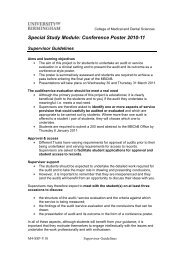Contents - College of Medical and Dental Sciences - University of ...
Contents - College of Medical and Dental Sciences - University of ...
Contents - College of Medical and Dental Sciences - University of ...
You also want an ePaper? Increase the reach of your titles
YUMPU automatically turns print PDFs into web optimized ePapers that Google loves.
The 11 th International Workshop on KSHV & Related Agents, Birmingham, UK<br />
Virus-Cell Interactions I Abstract 28<br />
KAPOSI’S SARCOMA ASSOCIATED HERPESVIRUS (KSHV/HHV-8) UTILIZES<br />
MACROPINOCYTIC PATHWAY TO ENTER HUMAN DERMAL MICROVASCULAR<br />
ENDOTHELIAL (HMVEC-D) AND HUMAN UMBILICAL VEIN ENDOTHELIAL<br />
(HUVEC) CELLS<br />
Hari Raghu, Neelam Sharma Walia, Mohanan Valiya Veettil, Sathish Sadagopan <strong>and</strong> Bala<br />
Ch<strong>and</strong>ran<br />
H.M. Bligh cancer research laboratories, Department <strong>of</strong> Microbiology <strong>and</strong> Immunology,<br />
H.M. Bligh Cancer Research Laboratories, Chicago <strong>Medical</strong> School, Rosalind Franklin<br />
<strong>University</strong> <strong>of</strong> Medicine <strong>and</strong> Science, 3333 Green Bay Road, North Chicago, IL. USA<br />
Abstract<br />
KSHV utilizes the clathrin mediated endocytic pathway for its infectious entry into human<br />
foreskin fibroblast (HFF) cells (J.Virology. 2003. 77: 7978-7990). Here, we characterized<br />
KSHV entry in primary HMVEC-d <strong>and</strong> HUVEC cells. Similar to HMVEC-d cells, KSHV<br />
infection <strong>of</strong> HUVEC cells also resulted in the initial high level lytic ORF50 <strong>and</strong> K8 gene<br />
expression <strong>and</strong> subsequent decline, while the latent gene expression persisted. In<br />
contrast to HFF cells, cytochalasin D affecting actin polymerization significantly blocked<br />
virus entry <strong>and</strong> gene expression in both endothelial cell types tested. Chlorpromazine, a<br />
clathrin mediated endocytosis inhibitor which inhibited KSHV entry in HFF cells did not<br />
have any effect on KSHV binding, internalization <strong>and</strong> gene expression in HMVEC-d <strong>and</strong><br />
HUVEC cells. No significant inhibition was observed in both the endothelial cell types with<br />
filipin, a caveolar endocytosis inhibitor. In contrast, internalization <strong>and</strong> gene expression<br />
was significantly inhibited in both the endothelial cell types by macropinocytosis<br />
inhibitors EIPA <strong>and</strong> Rottlerin. Internalized virus particles enclosed in large vesicles were<br />
seen by electron microscopy. Confocal microscopy localized the viral capsid with KSHV<br />
envelope glycoprotein gpK8.1A at 5’ <strong>and</strong> 10’ post infection. Inhibition <strong>of</strong> macropinocytosis<br />
resulted in the distribution <strong>of</strong> viral capsids at the cell periphery <strong>and</strong> very little association<br />
with microtubules. Internalized viral glycoprotein gpK8.1A was associated with dextran, a<br />
marker for macropinocytosis, <strong>and</strong> KSHV entry in HMVEC-d cells was dynamin<br />
independent. Although KSHV was not associated with the early endosome marker EEA-1,<br />
internalized KSHV was associated with Rab5 <strong>and</strong> Rab34 GTPases that are known to<br />
regulate macropinocytosis. Taken together, these findings suggest that for its infectious<br />
entry in HMVEC-d <strong>and</strong> HUVEC cells, KSHV utilizes a macropinocytic pathway.<br />
Presenting author Email: bala.ch<strong>and</strong>ran@rosalindfranklin.edu<br />
51















